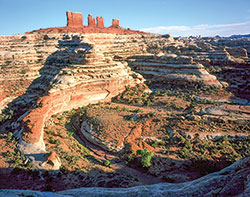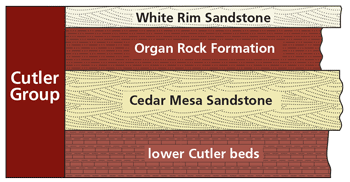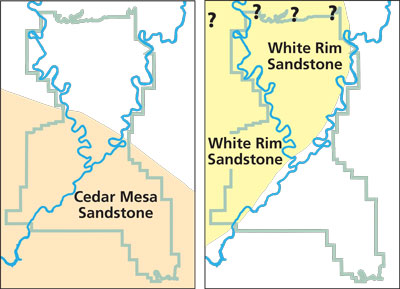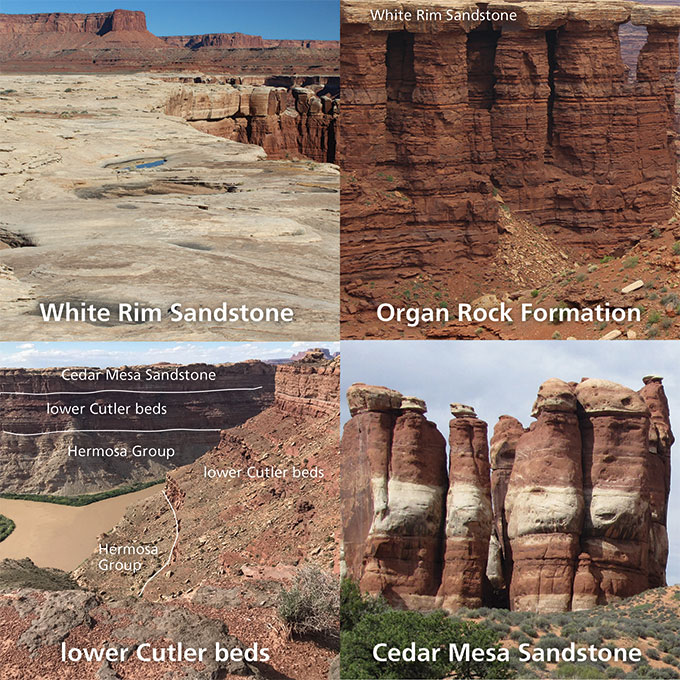 |
| The Organ Rock Formation overlying the Cedar Mesa Sandstone in the Maze District. Very thin remnants of the White Rim Sandstone cap the Chocolate Drops. NPS photo. |
With the notable exception of the five national parks named for types of plants*, geology gives most national parks their distinctive and superlative features. In fact, many national parks can be described as having a signature rock layer or rock type; that is, the specific geologic resources that make up its defining features. The scenery of Arches National Park is mostly due to the Entrada Sandstone. Yosemite has its granite domes, Zion National Park its Navajo Sandstone soaring cliffs, and Bryce Canyon, its colorful hoodoos of eroding Claron Formation. Even Everglades National Park is largely shaped by the underlying limestone.
For Canyonlands National Park, the Cutler Group is that rock unit. The Cutler Group differentiates Canyonlands from nearby national parks, and, in fact, from all other places in southeastern Utah. Canyonlands shares some rock layers (formations to geologists) with surrounding areas, such as the Wingate Sandstone and Kayenta Formation that also make the red cliffs near Moab. But many of the iconic places in Canyonlands, including the White Rim, Monument Basin, and the rounded rock spires (the Needles and the Doll House), are what they are because of the Cutler Group.
The Cutler Group consists of several different formations in Canyonlands National Park. In stratigraphy (the study of rock layers), a group is a hierarchical ranking above formation (the most basic unit in stratigraphic classification).
In the big picture, the Cutler Group consists of sediments shed off of the Ancestral Rocky Mountains of western Colorado during the Permian Period (approximately 290 to 275 million years ago). Closer to the ancient mountains, the Cutler consists of thick deposits of coarse red sediments and it isn’t possible to break it up into separate formations.
 |
| The units of the Cutler Group in the central part of Canyonlands National Park near the confluence. |
But in Canyonlands, the Cutler Group is divided into four separate layers: the lower Cutler beds, Cedar Mesa Sandstone, Organ Rock Formation, and White Rim Sandstone. Subtle differences in paleogeography, ancient climates, and depositional environments made different rock deposits in different areas of the park. All four units are present in the park’s center near where the rivers join, but otherwise, each district of the park has its own suite of Cutler Group rocks.
The oldest part of the Cutler Group in Canyonlands is informally known as the lower Cutler beds. The lower Cutler beds consists of thin limestone and mudstone beds, with some sandstone. What to call these layers is a bit controversial among researchers. They have been mapped as the Halgaito Formation and Elephant Canyon Formation by some geologists, but others think that these units do not follow the proper stratigraphic naming conventions, and they instead use the term lower Cutler beds as a catch-all.
Whatever they are called, these rocks are exposed in some canyon bottoms in the southeastern part of Canyonlands (Needles District) and in the upper walls of Cataract Canyon.
 |
| Maps showing the paleogeography of the ergs that formed the Cedar Mesa and White Rim Sandstones. The White Rim Sandstone is also slightly younger than the Cedar Mesa Sandstone. |
The Cedar Mesa Sandstone is the iconic rock layer of both the Needles and Maze districts where it erodes into labyrinth-like canyons and rock spires. The Cedar Mesa is eolian in origin, meaning it was deposited by winds in an erg (sand dune field). The Needles District is close to the northeastern edge of the Cedar Mesa erg and the sandstone thickens towards the west.
The dark red Organ Rock Formation sits between two light-colored layers: the Cedar Mesa Sandstone below and the White Rim Sandstone above. In Canyonlands, the Organ Rock Formation consists mostly of sandstone, siltstone, and pebbly conglomerate deposited in river channels and floodplains and in small sand dune areas. Its thin horizontal beds can form vertical walls and spires where protected by a cap of the hard White Rim Sandstone. The Organ Rock’s most famous exposure is in Monument Basin below the Island in the Sky’s Grandview Point.
The White Rim Sandstone is at most a few hundred feet thick. But it is very resistant to erosion, especially relative to the underlying Organ Rock Formation and the overlying Moenkopi Formation. Through differential erosion, it forms an eponymous bench (the White Rim) below the Island in the Sky mesa.
Like the Cedar Mesa Sandstone, the White Rim was deposited in a fairly large erg that extended to the west. Its eastern edge was near the current location of the Colorado River. Therefore, the White Rim Sandstone is much thicker near the Green River and in the Maze than it is on the eastern side of the White Rim bench.
The variations in the Cutler Group in Canyonlands is a big part of the reason why the three park districts are so distinctive from each other. The Needles District is nearly synonymous with the Cedar Mesa Sandstone, but has some exposures of the lower Cutler beds. The Maze District is mostly made of three Cutler layers: Cedar Mesa, Organ Rock, and White Rim. And in the Island in the Sky District, except for the confluence, the Cutler consists of the dark red Organ Rock overlain by the White Rim.
That the layers in the Cutler Group vary from place to place in Canyonlands shows the connections between the paleogeography of the ancient past when they were deposited and the scenery of this spectacular national park today.
*Saguaro, Joshua Tree, Sequoia, and Redwood national parks, and Organ Pipe Cactus National Monument.
 |
| The units of the Cutler Group in the central part of Canyonlands National Park near the confluence. |
|